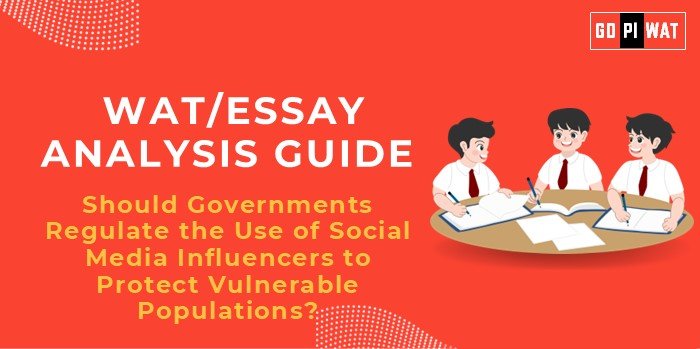📋 WAT/Essay Analysis Guide
Should Governments Regulate the Use of Social Media Influencers to Protect Vulnerable Populations?
🌐 Understanding the Topic’s Importance
Regulating influencers touches on broader issues like digital ethics, consumer protection, and the responsibilities of emerging professions. This topic’s significance lies in its implications for marketing, policy-making, and societal well-being.
📝 Effective Planning and Writing
Time Allocation:
- Planning: 5 minutes.
- Writing: 20 minutes.
- Reviewing: 5 minutes.
🔗 Structuring the Essay
Introduction Techniques:
- Contrast Approach: “While influencers inspire millions, unchecked promotion risks misinformation and exploitation.”
- Solution-Based Introduction: “Government regulation offers a framework to balance creativity and accountability.”
Body Paragraphs:
- Achievements: Improved transparency, ethical marketing.
- Challenges: Misinformation, youth exploitation.
- Future Outlook: Global lessons, self-regulation, and ethical growth.
Conclusion Templates:
- Balanced Perspective: “Regulation is a tool to ensure ethical content while supporting creative industries.”
- Global Example-Based: “Learning from Norway and Australia, balanced regulation can protect consumers and sustain growth.”
💡 Recommendations for Sustainable Progress
- Self-regulation through influencer associations.
- Partnering with platforms for content verification.
- Educating audiences about digital literacy.
📄 Sample Short Essays
Balanced Perspective:
Social media influencers are powerful yet unregulated forces shaping behavior. Government oversight, modeled on international best practices, can enhance transparency and protect the vulnerable while fostering ethical growth.
Solution-Oriented:
Regulation of influencers is vital to curb misinformation and exploitation. Governments must collaborate with platforms and influencers to develop practical, enforceable policies ensuring content accountability.
Global Comparison:
Countries like Norway show the potential of balanced influencer regulations to mitigate harms without curtailing creativity. India could adapt such models to address unique local challenges in protecting vulnerable groups.


